Abbreviated New drug Application (ANDA)
Abbreviated New drug Application (ANDA). By : Mrs. Reenoo Jauhari Asst. Prof. Department of Pharmaceutical science SGRRITS, Dehradun. INTRODUCTION.
Share Presentation
Embed Code
Link
Download Presentation
- drug
- drug product
- generic drug
- listed drug
- chemistry microbiology review
- generic drug product provided

jocchipinti + Follow
Download Presentation
Abbreviated New drug Application (ANDA)
An Image/Link below is provided (as is) to download presentation Download Policy: Content on the Website is provided to you AS IS for your information and personal use and may not be sold / licensed / shared on other websites without getting consent from its author. Content is provided to you AS IS for your information and personal use only. Download presentation by click this link. While downloading, if for some reason you are not able to download a presentation, the publisher may have deleted the file from their server. During download, if you can't get a presentation, the file might be deleted by the publisher.
Presentation Transcript
- Abbreviated New drug Application (ANDA) By: Mrs. ReenooJauhari Asst. Prof. Department of Pharmaceutical science SGRRITS, Dehradun
- INTRODUCTION • “ANDA” is the abbreviation for “Abbreviated New Drug Application”. It contains data which when submitted to FDA’s Center for Drug Evaluation & Research, Office of Generic Drug, provides for the review & ultimate approval of a generic drug product. • Once approved an applicant may manufacture & market the generic drug product provided all issues related to patent protection, safe, effectiveness, low cost alternative to the public. Mrs. ReenooJauhari, Asst. prof., Dept. of Pharmacy, SGRRITS, Dehradun
- Generic drug applications are termed “abbreviated” because they are generally not required to include preclinical (animal) & clinical (human) data to establish safety & effectiveness. • A generic drug product is one that is comparable to an innovator drug product in dosage form, strength, route of administration, quality, performance characteristics & intended use. Mrs. ReenooJauhari, Asst. prof., Dept. of Pharmacy, SGRRITS, Dehradun
- All approved products, both innovator & generic, are listed in FDA’s Approved Drug Products with Therapeutic Equivalence Evaluations. • Generic applicants must scientifically demonstrate that their product is bioequivalent (i.e. performs in the same manner as the innovator drug). • The rate of absorption or bioavailability of the generic drug, is compared to that of the innovator drug. • The generic version must deliver the same amount of active ingredients into a patient’s bloodstream in the same amount as that in the innovator drug. Mrs. ReenooJauhari, Asst. prof., Dept. of Pharmacy, SGRRITS, Dehradun
- Using bioequivalence as the basis for approving generic copies of the drug products was established by the “Drug Price Competition & Patent Term Restoration Act of 1984”, also known as the Waxman-Hatch Act. • At the same time, the branded name companies can apply for up to five additional years longer patent protection for the new medicines they developed to make up for time lost while their products were going through FDA’s approval process. • Generic drug application reviewers focus on bioequivalence data, chemistry & microbiology data, request for plant inspection, & drug labelling information. Mrs. ReenooJauhari, Asst. prof., Dept. of Pharmacy, SGRRITS, Dehradun
- ANDA Requirements • Signed FDA form 356h. Provides information regarding the applicants name & address, name of the drug product, the product strength & route of administration, indication of drug master files cited, proposed indications, a statement regarding whether the product is for prescription or over the counter. • An index should specify volume & page number for each complete & detailed item. • Information on the basis for which the ANDA is being submitted. a) Name of the reference drug, its dosage form & strength. b) Information on exclusively for the listed drug. c) If a suitability petition is approved a reference to the FDA number that was assigned to that suitability petition. Mrs. ReenooJauhari, Asst. prof., Dept. of Pharmacy, SGRRITS, Dehradun
- Condition for use, including, • A statement regarding the condition for which the drug will be used. • A reference to the annoted labelling for the product & the currently approved labelling for the listed product drug. • A statement that active ingredient is the same as for that of the reference drug. For the combination product this must be shown for both active ingredient. • Route of administration, dosage form & strength. This should include a statement that the route of administration, dosage form & strength are same as the reference drug. Bioequivalence. This should include information to demonstrate that the proposed drug is bioequivalent to the listed drug product. Mrs. ReenooJauhari, Asst. prof., Dept. of Pharmacy, SGRRITS, Dehradun
- Labeling. Include a copy of currently approved labeling for the listed drug as well as the proposed labeling for the drug being provided for in the ANDA. A side by side comparison of two sets of labeling is also necessary. • Chemistry, Manufacturing & Controls. Describe the composition, manufacture, specifications & analytical procedures for the drug substance & drug product. • Human Pharmacokinetics & Bioavailability. This include information concerning • The Design • The Dosing procedure • The number & frequency of blood & urine collection & Methodology for the assay. Mrs. ReenooJauhari, Asst. prof., Dept. of Pharmacy, SGRRITS, Dehradun
- Samples. • The sample of the Drug substance & finished product should be provided four individuals units with sufficient quantities in each unit to permit the FDA to perform all the tests included in the specifications at least three times. • Analytical method for drug substance & drug product. This section should consists of the specifications, analytical method, certificates of analysis, method of analysis, method validation & stability indicating data as contained in the chemistry, manufacturing & control part of the application. • Labelling. 12 specimen of the final printed label & all labelling for the drug product are to be included. • Case report form and tabulations. The need for these should be discussed with appropriate personal of the division of bioequivalence prior to submission of the ANDA. Mrs. ReenooJauhari, Asst. prof., Dept. of Pharmacy, SGRRITS, Dehradun
- Mrs. ReenooJauhari, Asst. prof., Dept. of Pharmacy, SGRRITS, Dehradun
- Mrs. ReenooJauhari, Asst. prof., Dept. of Pharmacy, SGRRITS, Dehradun
- Procedure after the application • An applicant means any person (usually a pharmaceutical firm) who submits an abbreviated new drug application, or an amendment or supplement to them, to obtain FDA approval to market a generic drug product. • Acceptable & Complete? • An application must contain sufficient information to allow a review to be conducted in an efficient & timely manner. • Upon receipt of the application a pre-filling assessment of its completeness & acceptability is performed by a project manager within the regulatory support branch, Office of Generic Drugs. • If this initial review documents that the applicant contains all the necessary components, an “acknowledgment letter” is sent to the applicant. Mrs. ReenooJauhari, Asst. prof., Dept. of Pharmacy, SGRRITS, Dehradun
- Refuse to file letter issued: • If the application is missing one or more essential components, a “Refuse to File” letter is sent to the applicant. • No further review of the application occurs until the applicant provides the requested data & the application is found acceptable & complete. Mrs. ReenooJauhari, Asst. prof., Dept. of Pharmacy, SGRRITS, Dehradun
- Bioequivalence Review: • The Bioequivalence Review process established that the proposed generic drug is bioequivalent to the reference listed drug, based upon a demonstration that both the rate & extent of absorption of the active ingredient of the generic drug fall within established parameters when compared to that of the reference listed drug. • Applicants may request a waiver from performing in vivo (testing done in humans) bioequivalence studies for certain drug products where bioavailability may be demonstrated by submitting data such as 1) a formulation comparison for products whose bioavailability is self evident, for example, oral solutions, injectable, or ophthalmic solutions where the formulations are identical, or 2) comparative dissolution. Mrs. ReenooJauhari, Asst. prof., Dept. of Pharmacy, SGRRITS, Dehradun
- Alternatively, in vivo bioequivalence testing comparing the rate & extent of absorption of the generic vs. the reference product is required for most tablet & capsule dosage forms. For certain products, a head to head evaluation of comparative efficacy based upon clinical endpoints may be required. Mrs. ReenooJauhari, Asst. prof., Dept. of Pharmacy, SGRRITS, Dehradun
- Chemistry/Microbiology Review: • The Chemistry/Microbiology review process provides assurance that the generic drug will be manufactured in a reproducible manner under controlled conditions. • Areas such as the applicant’s manufacturing procedures, raw material specifications & controls, sterilization process, container & closure systems, accelerated & room temperature stability data are reviewed to assure that the drug will perform in an acceptable manner. Mrs. ReenooJauhari, Asst. prof., Dept. of Pharmacy, SGRRITS, Dehradun
- Labeling Review: • The labeling review process ensures that the proposed generic drug labeling (package insert, container, package label & patient information) is identical to that of the reference listed drug except for differences due to changes in the manufacturer, distributor, pending exclusively issues, or other characteristics inherent to the generic drug product (tablet size, shape or color, etc.). • Furthermore, the labelling review serves to identify & resolve issues that may contribute to medication errors such as similar sounding or appearing drug names, & the legibility or prominence of the name or strength. Mrs. ReenooJauhari, Asst. prof., Dept. of Pharmacy, SGRRITS, Dehradun
- Bioequivalence Review Acceptable? • If at the conclusion of the Bioequivalence Review, it is determined that there are deficiencies in the bioequivalence portion of the application, a bioequivalence Deficiency Letter is issued by the division of Bioequivalence to the applicant. • This deficiency letter details the deficiencies & requests information & data to resolve them. Mrs. ReenooJauhari, Asst. prof., Dept. of Pharmacy, SGRRITS, Dehradun
- Chemistry/Microbiology/Labeling Review Acceptable? • If there are deficiencies involved in the Chemistry/Manufacturing/Controls, Microbiology or Labelling portions of the application, these deficiencies are communicated to the applicant in a facsimile. • The facsimile instructs the applicant to provide information & data to address the deficiencies & provides regulatory direction on how to amend the application. • Once the above sections are found to be acceptable, as well as, the pre-approval inspection & bioequivalence portion of the application, then the application moves toward approval. Mrs. ReenooJauhari, Asst. prof., Dept. of Pharmacy, SGRRITS, Dehradun
- Pre-approval Inspection Acceptable? • The pre-approval inspection determines compliance with Current Good Manufacturing Practices (cGMPs) as well as a product specific evaluation concerning the manufacturing process of the application involved. • If an unsatisfactory recommendation is received, a not approvable letter may be issued. Mrs. ReenooJauhari, Asst. prof., Dept. of Pharmacy, SGRRITS, Dehradun
- ANDA Approved: • After all components of the application are found to be acceptable an approval or tentative approval letter is issued to the applicant. • If the approval occurs prior to the expiration of any patents or exclusivities accorded to the reference listed drug product, a tentative approval letter is issued to the applicant which details the circumstances associated with the tentative approval of the generic drug product & delays approval until all patent/exclusivity issues have expired. • A tentative approval does not allow the applicant to market the generic drug product. Mrs. ReenooJauhari, Asst. prof., Dept. of Pharmacy, SGRRITS, Dehradun
- REFERENCES: 1) New Drug Approval Process, Richard Gaurino, Marcel DekkerINC, New York, 2nd Edition, Vol.56, 189-212. 2) www.fda.gov. Mrs. ReenooJauhari, Asst. prof., Dept. of Pharmacy, SGRRITS, Dehradun

DRUG DISCOVERY – NEW DRUG DEVELOPMENT PROCESS
DRUG DISCOVERY – NEW DRUG DEVELOPMENT PROCESS. BY. Dr. BASAVARAJ K. NANJWADE. Department of Pharmaceutics K L E UNIVERSITY JN MEDICAL COLLEGE BELGAUM – 590010 E-mail: bknanjwade@yahoo.co.in. DRUG.
1.54k views • 55 slides
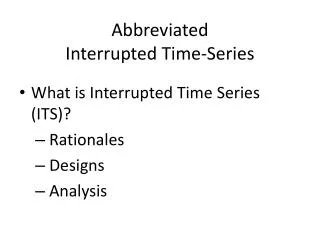
Abbreviated Interrupted Time-Series
Abbreviated Interrupted Time-Series. What is Interrupted Time Series (ITS)? Rationales Designs Analysis. What is ITS?. A series of observations on the same dependent variable over time
1.79k views • 107 slides
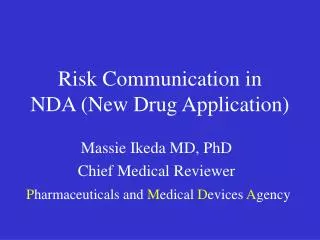
Risk Communication in NDA (New Drug Application)
Risk Communication in NDA (New Drug Application). Massie Ikeda MD, PhD Chief Medical Reviewer P harmaceuticals and M edical D evices A gency. Standard Disclaimer. This is not an official PMDA/MHLW guidance or policy statement.
656 views • 42 slides
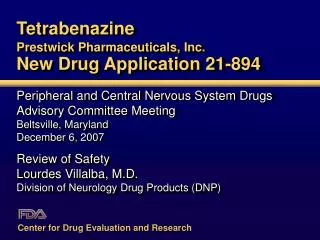
Tetrabenazine Prestwick Pharmaceuticals, Inc. New Drug Application 21-894
Tetrabenazine Prestwick Pharmaceuticals, Inc. New Drug Application 21-894. Peripheral and Central Nervous System Drugs Advisory Committee Meeting Beltsville, Maryland December 6, 2007 Review of Safety Lourdes Villalba, M.D. Division of Neurology Drug Products (DNP).
743 views • 48 slides

ABBRIVIATED NEW DRUG PPLICATION (ANDA)
SEMINAR ON:. ABBRIVIATED NEW DRUG PPLICATION (ANDA). Presented by: Nagori Stavan Arunkumar Department of Pharmaceutics L.M.College of Pharamcy. ANDA. Pool of topics:. Introduction History of ANDA Guidelines available for ANDA Filling of ANDA
2.28k views • 129 slides
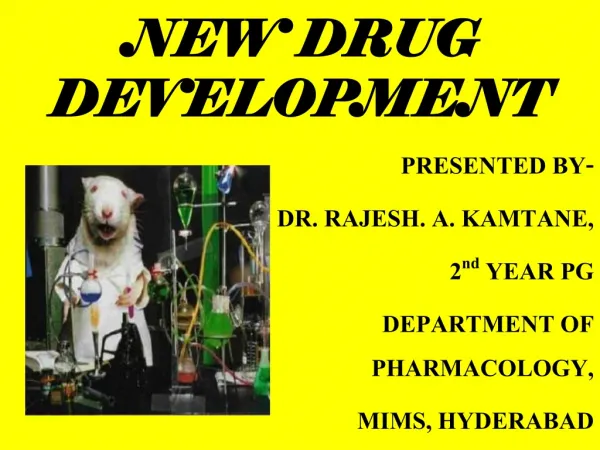
NEW DRUG DEVELOPMENT
This ppt describes the process of new drug development.
1.37k views • 65 slides
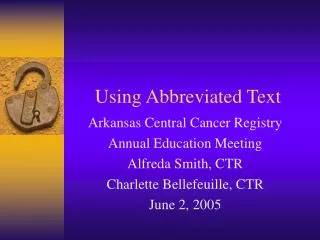
Using Abbreviated Text
Using Abbreviated Text. Arkansas Central Cancer Registry Annual Education Meeting Alfreda Smith, CTR Charlette Bellefeuille, CTR June 2, 2005. About Text Fields. Text documentation is an essential component of a complete electronic abstract. Rationale.
433 views • 42 slides

NDA NEW DRUG APPLICATION
NDA NEW DRUG APPLICATION. 1/50. NEW DRUG APPLICATION. Introduction :
1.91k views • 50 slides
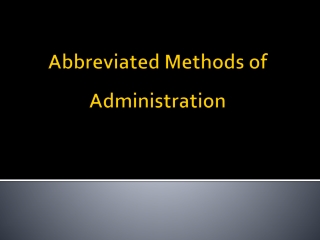
Abbreviated Methods of Administration
Abbreviated Methods of Administration. 1. Muniment of Title. Useful if will is needed only to prove title transfer. Within four years of death No unpaid creditors other than those secured by real property, or For other reason no administration is needed. After four years of death
551 views • 45 slides
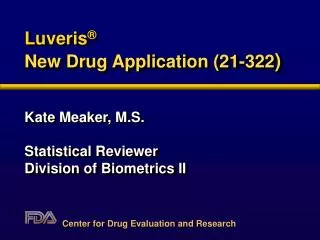
Luveris ® New Drug Application (21-322 )
Luveris ® New Drug Application (21-322 ). Kate Meaker, M.S. Statistical Reviewer Division of Biometrics II. Center for Drug Evaluation and Research. Objectives. Present FDA analyses of three main studies Discuss lack of sufficient evidence of efficacy. Main Issue.
427 views • 24 slides
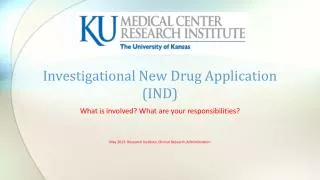
Investigational New Drug Application (IND)
Investigational New Drug Application (IND). What is involved ? What are your r esponsibilities? May 2013: Research Institute, Clinical Research Administration. Topics. Definition of IND R oles and Responsibilities of: Sponsor Investigator Sponsor-Investigator When an IND needed
1.41k views • 18 slides
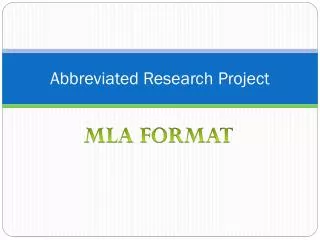
Abbreviated Research Project
Abbreviated Research Project . MLA FORMAT. Getting Started– Page 1. Should include: Page number in the top right of every page with your last name Header on the left Title in the middle. Page 1 Step-by-Step. To include page numbers (on the right side of the page):
194 views • 12 slides
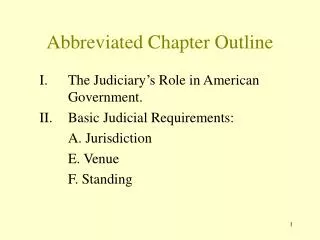
Abbreviated Chapter Outline
Abbreviated Chapter Outline. The Judiciary’s Role in American Government. Basic Judicial Requirements: A. Jurisdiction E. Venue F. Standing. §2: Basic Judicial Requirements.
348 views • 14 slides
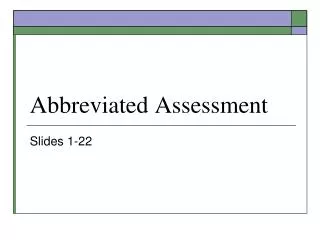
Abbreviated Assessment
Abbreviated Assessment. Slides 1-22. Neuro Assessment. Neuro Assessment.
971 views • 59 slides

Investigational New Drug Application 21 CFR Part 312
A Review for OCRA US RAC Study Group September 2005 Ginger Clasby, MS Promedica International gclasby@promedica-intl.com 714-799-1617 x 25. Investigational New Drug Application 21 CFR Part 312. IND Application About the Regulation.
651 views • 30 slides

New Application
JHMeIRB. New Application. eIRB Login. Login to eIRB at http://e-irb.jhmi.edu. Investigator Home Page. Tool Bar eIRB Helpdesk Step by step instructions and tutorials Contact information eIRB Survey submit your feedback to the IRB What’s New
806 views • 64 slides

Clinical Review Process for New Drug Development and Application
Clinical Review Process for New Drug Development and Application. Shen Xiao, MD, Ph.D. Senior Medical Officer Division of Cardiovascular and Renal Products Center for Drug Evaluation and Research (CDER) US FDA. Disclaimer.
133 views • 9 slides

Risk Communication in NDA (New Drug Application)
Risk Communication in NDA (New Drug Application). Massie Ikeda MD, PhD Chief Medical Reviewer P harmaceuticals and M edical D evices A gency. Standard Disclaimer. This is not an official PMDA/MHLW guidance or policy statement.
446 views • 42 slides

Abbreviated Injury Scale
Abbreviated Injury Scale. Measures of severity ICE on injury statistics Maria Segui-Gomez. Agenda. Brief history Uses and overuses Advantages/limitations over other severity measures common criticisms. Disclaimer.
381 views • 16 slides





















